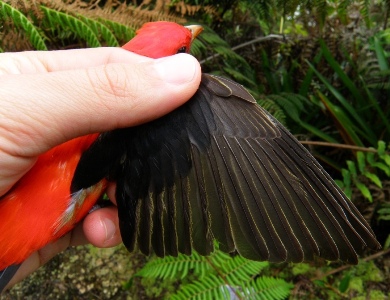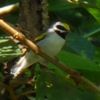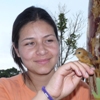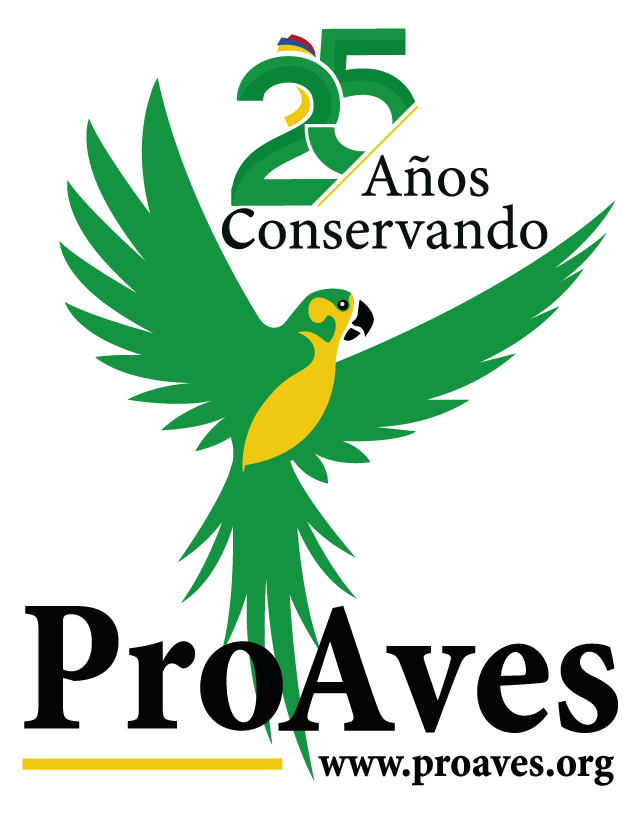 |
| Oreothlypis peregrina |
The National Programme for the Monitoring and Preservation of Migratory Birds is a ProAves Foundation initiative carried out with the cooperation of Preservation International so as to monitor and preserve endangered neotropical migrant birds with the help of the 27 monitoring stations existing in Colombia.
Nearly 183 neotropical migrants arrive each year in Colombia and from here they spread throughout the South American continent. Unfortunately, the critical areas and habitats on which they depend are threatened due to their over-exploitation or destruction. ProAves Foundation and Preservation International launched in 2003 the Colombian Monitoring and Preservation Programme for Migratory Birds, a pioneer initiative in Latin America
This programme seeks to consolidate a strategic network for bird monitoring, to raise awareness of the importance of preserving these species and their natural habitats in Colombia and to increase the national capacity to undertake studies and preservation actions regarding migratory birds and their habitats.
The main achievements upon completion of Phase II of the programme in July 2007 were:
Protection and management of bird populations
First protected area for the preservation of migratory birds in Latin America. Establishment and expansion of the Reinita Cielo Azul Bird Reserve. The protected area includes oak and shadowy coffee forests, ideal habitat for the main species of the reserve, the Cerulean Warbler (Dendroica cerulea).
Pauxi pauxi Bird Reserve. 1347 hectares to protect the species Cerulean Warbler in the Hill la Paz (department of Santander), main winter residence area for this species. It also protects nine endangered species.
Bird Information System online.A database with 260,000 entries of data resulting from the monitoring process and that follow national and international standards so as to facilitate the exchanges of information. MySQL on-line platform. There is a record of about 57% of the total number of birds, 75% of land migratory birds, 64% of the endemic birds and near-endemic and 44% of threatened birds in Colombia (54% critically endangered, 48% endangered and 40% vulnerable).
 |
| Dendroica cerulea |
Maintenance, management, protection and restoration of the habitat for neotropical migratory birds
Migratory Bird Action Plan implemented in Colombia. 95 species of migratory birds and 82 endangered species. 53.5% of the 155 species in this category for Colombia are preserved in 12,660 acres under protection agreements signed for critical areas. These protection agreements have been approved with the help of the Colombian Network of Civil Society Reserves (CNCSR) and ProAves Foundation:
a) 10 protected areas administered by the ProAves Foundation. 1 protected area administered in partnership with the CNCSR . Five Reserves established in 2006 and three in 2005.
b) 1347 ha of the Pauxi pauxi Bird Reserve in Betulia, Santander. 2006.
c) 1 hectare Chincherry Bird Reserve. San Andres Island, Archipelago.
d) 100 acres Orejiamarillo Parrot Bird Reserve. Jardín, Antioquia.
e) 529 acres El Dorado Bird Reserve.Sierra Nevada de Santa Marta. February 2006.
f) 220 acres Reinita Cielo Azul Bird Reserve, San Vicente de Chucuri, Santander.
g) 1100 hectare Mirabilis-Swarovski Bird Reserve. Munchique, Cauca.July 2005.
Ecological Restoration. Creation of nurseries in the Orejiamarillo Parrot Bird Reserve with an annual production of 10,000 young plant productions. Project for forestry and grazing techniques implemented in the Reserves of the Civil Society. Implementation of the work plan for the ecologic easement in Antioquia, 2005.
Preservation Coffee plantation for the Cerulean Warbler. Marketing and sales by the American Bird Conservancy of the specialty coffee Cerulean Warbler.
Strengthening institutional capacity. Meetings on protected areas, annual plannings and Ecoguide courses.
Research and monitoring

Consolidation of a strategic network for bird monitoring. 27 banding stations in operation since November 2003 spread throughout four of the five regions of Colombia: Andean, Caribbean, Pacific and Amazonia.199 people linked to the program, 37 banders, 105 field assistants and 57 local volunteers.
Strategic alliances. Banding Seabirds and university banding groups.
First bird observatory in San Andres Island, Colombia. Currently under construction.
Evaluated Banding methods.
National Bird Census.
Strengthening of a Banding system in Colombia. Construction of the foundations for the implementation of a national banding system. 12.355 banding historical data collected, 9000 bands distributed to 31 projects belonging to 22 organizations or individuals. Existing Website for Banding.
Capacity building for monitoring and banding.402 researchers, students, and amateur ornithologists across Colombia trained in bird monitoring techniques, in 9 classes in 6 different locations throughout the country with 39 instructors recognized both nationally and internationally:
1.National and International acknowledgement as an organization that offers regular ornithology courses at different levels.
2. Training of skilled people in banding.
Cooperación entre proyectos de aves migratorias: Cooperation between migratory birds projects:
a) Coordination in the Western Hemisphere of the Banding Network.
b) Initiative of the Western Hemisphere for Migratory Bird Species.
c) Participation in:
Cerulean Group. Participation and support of the activities of the group Cerúleo. Support for the postulation of the Cerulean Warbler in the list of threatened species of the United States.
Alianza Alas Doradas. Coordination of the research and preservation working group for the Reinita Alidorada in non-reproductive areas.
PriorityP Migratory AverAves Priority. Participation and support of the initiative Migratory AverAves Priority led by Cornell Laboratory.

Environmental education, awareness and community development
Mobile Environmental Classroom. The Mobile Environmental Classroom has travelled more than 30,000 miles rising ecological awareness in 46,206 people from 36 different municipalities belonging to 7 departments. There has been a very high participation of children between the age of 7 and 12 years. This age group has represented 67% of the individuals sensitized thanks to the Mobile Environmental Classroom.
Migratory Bird Festival 2006 outstretched to Ecuador and Peru.
Environmental Bird-Friendly groups. 3785 children and youth belonging to different environmental Bird-Friendly groups based in 5 departments and 7 municipalities. 46 Bird-Friendly schools belonging to 8 municipalities in 6 departments. 43 youth-related social services dealing with environmental issues in bird conservation. Implementation of Bird-Friendly Schools in the municipalities of Génova, Quindío and Roncesvalles and Tolima.
Disclosure.
a) Website with information and interactive games especially designed for Bird-Friendly children.
b) Educational materials: posters, stickers, bookmarks, shirts and caps related to the events that deal with environmental education. Second version of the Migratory Bird Didactic Book, Extreme Travellers, 2000 copies printed.
c) Media. High diffusion of environmental education events in the local and regional media.
d) Conferences, symposia, meetings, seminars.Participation in 8 international congresses, 3 national congresses and 4 regional.
e) Five publications.
 |
 |
 |
 |
Related news
$4.3 Million for Neotropical Migratory Birds and Habitat Conservation
Wednesday 11 May 2011.
The U.S. Fish and Wildlife Service announced today more than $4.3 million in grants for 34 projects that will support neotropical migratory bird conservation throughout the Western Hemisphere.
 |
Successful VI Banding course with emphasis on migratory and endangered birds
Tuesday 10 May 2011.
Meeting the expectations of participants, instructors and organizers, the VI banding course with emphasis on migratory and threatened birds, held from March 26 to April 3 in Minca and RNA El Dorado, was a success.
 |
Second year of the Golden-winged Warbler project
Monday 10 May 2010.
In order to produce a comprehensive non-breeding conservation plan for the Golden-winged Warbler, field surveys were undertaken for the second consecutive year. ProAves conducted explorations in area with the highest probability of occurrence of the species, according to predictive distribution models.
 |
Great results in the V Banding Course
Monday 10 May 2010.
With the ringing of 370 individuals the V course of banding with emphasis on migratory birds and endangered species was successfully completed. Organized by ProAves and supported by The Wetland Trust, it was attended by 20 students, two of whom were selected to attend intensive training in England.
 |
ACT for songbirds! Support funding for NMBCA
Wednesday 11 June 2008.
The alarming decline of migratory birds has prompted US lawmakers to consider an early reauthorization of the highly successful conservation program, the Neotropical Migratory Bird Conservation Act (NMBCA).
 |
Migratory birds loyal to Colombia
Friday 24 August 2007.
The fidelity of Neotropical migratory birds to a particular non-breeding site and habitat in Colombian was shown in the past season with the recapture of 17 individuals of eight different species.
